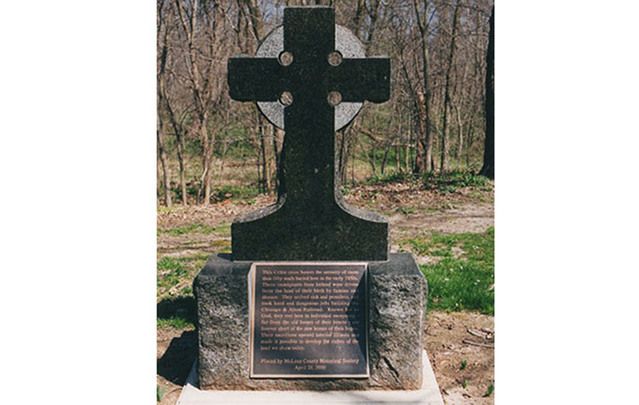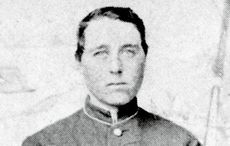In the mid-to-late 1800s, as many Irish fled their famine-stricken home country, thousands came to America to labor on the railroad systems that would connect the states as nothing had before.
Sadly, many of these men – and some women – would lose their lives along the tracks where they set down the rails, due to the grueling labor, the often rough work conditions and the rapid spread of diseases such as cholera and dysentery. Worse still, a great number of these workers were denied any sort of formal burial, their bodies simply left behind or put in a mass grave with other workers.
Perhaps the best-known instance of an Irish railroad workers mass grave can be found in Duffy's Cut, PA, which first made headlines 12 years ago when brothers Doctors Frank and William Watson began their investigation into the deaths of the Irish immigrants, spurred on by a file of evidence left by their grandfather. After years of research and testing, they were able to confirm that while some of the 57 Irish immigrants, most from County Derry, died from cholera, others were murdered, possibly by locals who believed they were responsible for spreading the disease.
Less well known are two mass graves of fifty Irish people who worked on the Illinois Central Railroad in Funks Grove, IL, a small village 12 miles south of Bloomington.
The grave site's unusual because the workers were buried in the local cemetery instead of by the tracks, all thanks to the kindness of one family, the Funks.
The family came to the area in 1824, when brothers Isaac and Abaslom Funk arrived there after leaving their family’s Ohio farm. Half a year later they were joined by their sister, Dorothy (Funk) Stubblefield and her husband, Robert, who set down roots in the area. The family chose the location of the church and cemetery in 1830, and in 1864-65 they built a new church building out of white pine shipped from the east coast. They maintained the church and the cemetery themselves until 1891.
Read more: The impact of the Irish on the American railroad system
So how did the fifty Irish men come to be buried in the Funk family plot, in two mass graves?
In the 1850s, central Illinois was flooded with thousands of rail workers, who labored to build over 2,700 miles of track in the state in just 10 years.
In an article on the Irish rail laborers of Central Illinois, Mike Matejka explains, “Famine-ravaged Irish families became the key foundation for pre-Civil War railroad and canal building in America. 75 cents to $1.50 a day was the standard wage rate, minus room, board and other expenses.” The Irish were the largest ethnic group listed in the payroll records for the Illinois Central railroad.
A cholera outbreak, sadly an all too common occurrence in the railroad labor camps, led to dozens of deaths among the workers, and the Funk family, the founders of Funk’s Grove, offered to let them be buried in their cemetery plot.
Matejka explains the significance of this gesture given the social climate of the place and time:
“The Funk family broke social barriers of the times in allowing Irish burials in their cemetery. Bloomington did not have a Catholic Church until 1853 and a cemetery until 1856. The reigning mayor, Franklin Pierce, was a "Know-Nothing," frequently attacking the growing Irish community on Bloomington's west side. Perhaps the Funk's Grove cemetery was a sanctuary for the growing Irish community, until they were able to establish their own burial spot, outside city limits, in 1856.”
While the exact fate of the Irish immigrants buried at Funk’s Grove remains unknown (local papers did not carry reports of any of the men’s deaths at the time,) Matejka does quote L. Jane Canfield, a Funk's Grove native, who remembered what her grandmother, Emily Jane Van Ness Wilcox, told her:
“She talked about how the young Irish men, some were fourteen or fifteen years old, who worked on the railroad in the early 1850s had migrated to the U.S. because of the famine in Ireland. They worked hard and lived in primitive conditions along the building site of the railroad. In the summer of 1853, many men, both young and old, came down with cholera and a large number of them died in a few days. Fear of the spreading disease, they were buried in a mass grave west of the Funk's Grove church.”
The presence of the graves endured in local memory. A Celtic cross monument was erected on April 28, 2000, following donations totaling $20,000 from Irish heritage groups, local unions and a few generous individuals to commemorate the Irish immigrants buried at Funk’s Grove. It reads:
"This Celtic cross honors the memory of more than fifty souls buried here in the early 1850s. These immigrants from Ireland were driven from the land of their birth by famine and disease. They arrived sick and penniless, and took hard and dangerous jobs building the Chicago & Alton Railroad. Known but to God, they rest here in individual anonymity – far from the old homes of their heirs – yet forever short of the new homes of their hopes. Their sacrifices opened interior Illinois and made it possible to develop the riches of the land we share today."
Do you know any stories or historical information of the Irish immigrants who built railroads in the US? Share them in the comment section, below.
* Originally published in May 2016.




Comments